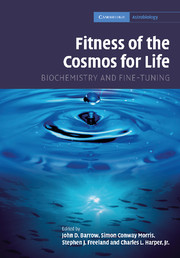Book contents
- Frontmatter
- Contents
- List of contributors
- Foreword: The improbability of life
- Preface
- Acknowledgments
- Part I The fitness of “fitness”: Henderson in context
- Part II The fitness of the cosmic environment
- Part III The fitness of the terrestrial environment
- Part IV The fitness of the chemical environment
- 16 Creating a perspective for comparing
- 17 Fine-tuning and interstellar chemistry
- 18 Framing the question of fine-tuning for intermediary metabolism
- 19 Coarse-tuning in the origin of life?
- 20 Plausible lipid-like peptides: prebiotic molecular self-assembly in water
- 21 Evolution revisited by inorganic chemists
- Index
- References
21 - Evolution revisited by inorganic chemists
Published online by Cambridge University Press: 18 December 2009
- Frontmatter
- Contents
- List of contributors
- Foreword: The improbability of life
- Preface
- Acknowledgments
- Part I The fitness of “fitness”: Henderson in context
- Part II The fitness of the cosmic environment
- Part III The fitness of the terrestrial environment
- Part IV The fitness of the chemical environment
- 16 Creating a perspective for comparing
- 17 Fine-tuning and interstellar chemistry
- 18 Framing the question of fine-tuning for intermediary metabolism
- 19 Coarse-tuning in the origin of life?
- 20 Plausible lipid-like peptides: prebiotic molecular self-assembly in water
- 21 Evolution revisited by inorganic chemists
- Index
- References
Summary
Introduction
If we inspect our surroundings on earth, we will see a myriad of materials, objects, natural and artificial constructions (many resulting from the activities of the human species), and, of course, an enormous variety of living organisms, from the simplest bacteria to the most complex animals. We can also inspect the sky and observe other planets, stars, galaxies, and clusters of galaxies far away in our expanding universe, leaving us wondering whether life can also be found elsewhere. Is it all an inevitable product of such a finely tuned construct as the universe seems to be, given appropriate local conditions? At a very basic level, it must be. We are an evolved species co-existing with many other simpler species on which we depend. All are made of the same chemical elements resulting from that fine-tuning that allowed their kinetically controlled formation in big stars and created our planet and the fields to which all life is exposed. Life must be a possibility included in a finely tuned cosmos – we sense it in our minds. We also know that it has evolved and diversified here on earth, although the reasons for this – that is, the factors that determined evolution – are not so obvious. This question has intrigued philosophers and scientists through the ages, and it reached public awareness toward the end of the eighteenth century.
- Type
- Chapter
- Information
- Fitness of the Cosmos for LifeBiochemistry and Fine-Tuning, pp. 456 - 490Publisher: Cambridge University PressPrint publication year: 2007
References
- 1
- Cited by



